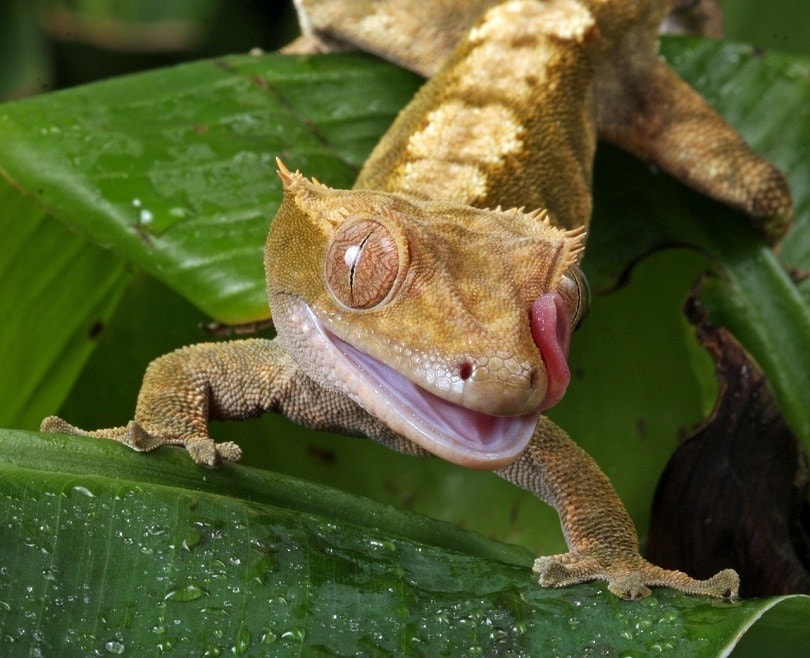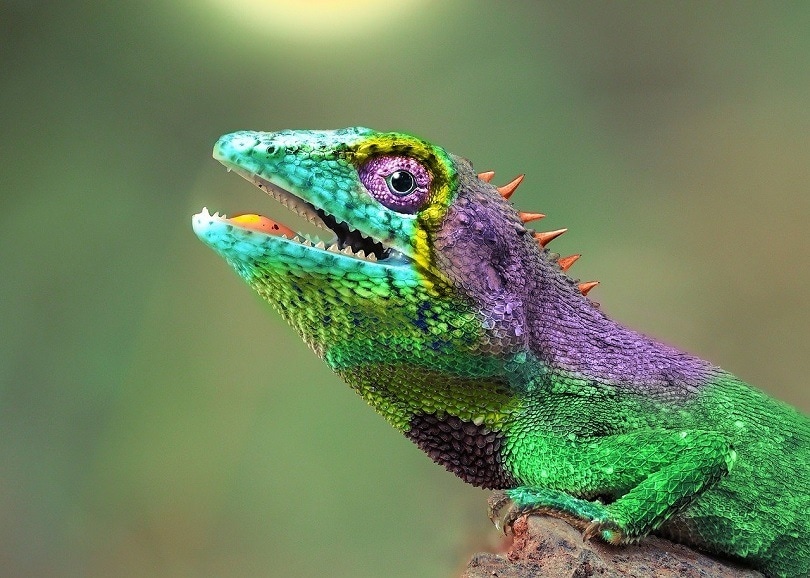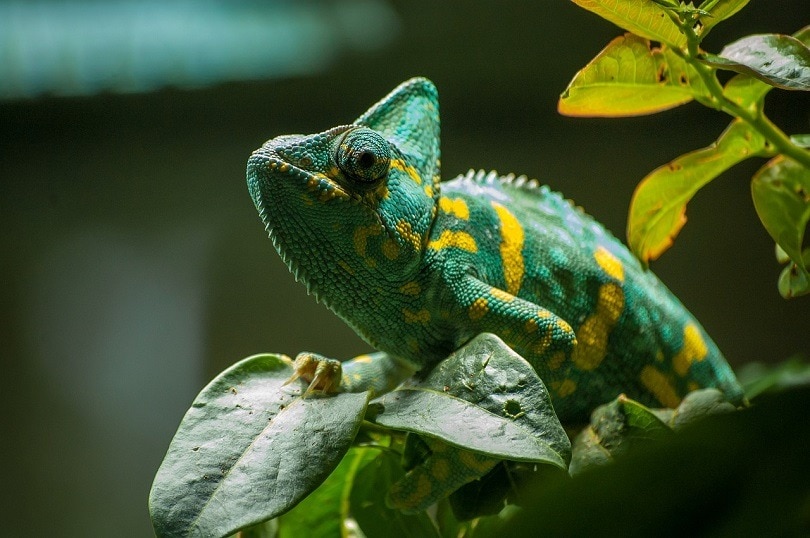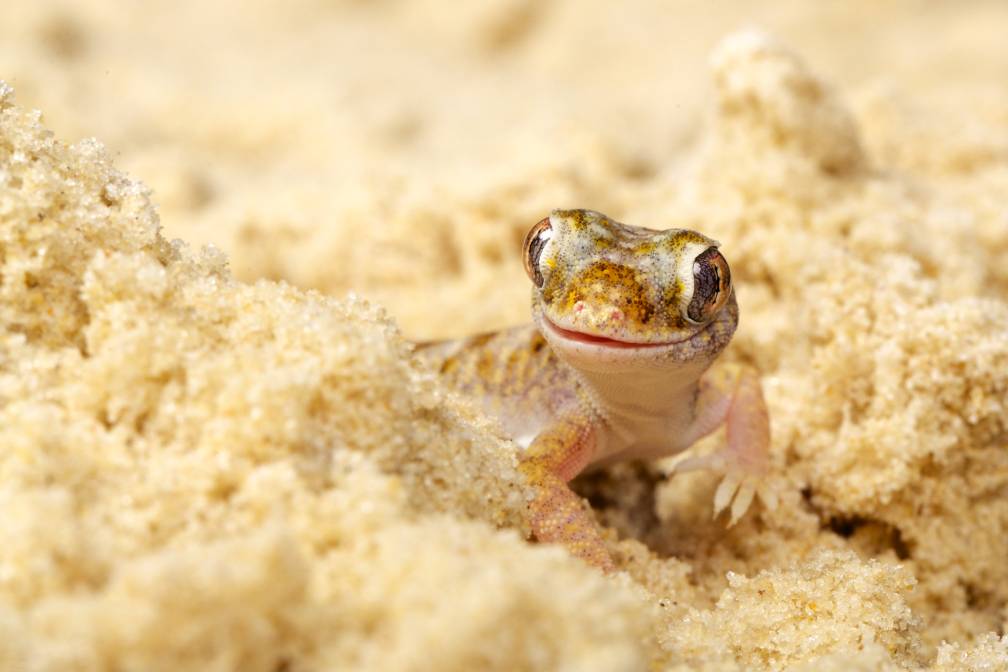
Click to Skip Ahead
Geckos and chameleons are among the most popular lizard pets in the world today. They are excellent options for people looking for non-conventional pets or reptile fans looking to care for a reptilian inside their homes.
While they may look somewhat alike, geckos and chameleons have significant differences that might influence your choice on which to pick between them. What’s more, there are numerous species of geckos and chameleons, with each species having unique attributes.
Therefore, it is important to familiarize yourself with the various pet species of chameleons and geckos so you can make an informed decision when you decide to adopt one. In this article, we shall discuss all the differences between common house geckos and chameleons, as well as the specific needs of each when kept as pets.
Visual Differences

At a Glance
Gecko Overview

The common house gecko traces its roots back to Southeast Asia. However, these lizards are now inhabitants of warm climates all over the world. It is believed that geckos found their way to the Americas by being stowaways in ships. Due to their rapid breeding rate, they quickly establish a domain wherever they go.
Common house geckos come in various colors, with the most common ones being a pale grey-white and a yellowish tan with black spots. Geckos do well in captivity as long as they have an attentive keeper. Like all reptiles, they are cold-blooded, meaning they don’t do well in colder climates. Therefore, if you are looking to keep a gecko in such a climate, you should be ready to provide them with a warm and humid enclosure.
Unfortunately, if you are looking for a pet that you can handle frequently, the gecko might not be for you. In addition to being too quick to handle, they do not seem to appreciate it. However, that can vary between geckos.
Personality / Character
While there are numerous gecko species, most tend to display similar behavioral patterns and traits. For the most part, they are docile and pleasant. However, geckos do not like frequent handling, and doing so might stress them.
These reptiles are nocturnal, meaning they are most active at night. However, species like the day gecko tend to be active during the day. But generally speaking, if you want to watch your little one go about their business, nighttime is the best time to do so.
Geckos are the only lizards with voice boxes. While they tend to be silent most of the time, they will occasionally vocalize by barking, chirping, and clicking. They usually vocalize when attracting a mate or defending their territory.
These lizards are typically docile, though it depends on the species. Most are docile unless you house two males together. Geckos do best alone, as they are solitary animals.

Housing
While the appropriate housing requirements might vary between species, most geckos need an enclosure with basic requirements, such as a water bowl, branches for climbing, and a hiding place. Make sure the enclosure has a secure lid, as geckos are notorious escape artists. The size of the enclosure is another factor that varies among gecko species. Most species, however, can do well with 10- or 20-gallon aquariums.
Remember, your pet is a cold-blooded animal. This means they need external sources of heat to maintain their body heat. At home, you will have to create artificial basking conditions. For starters, you will need to ensure that the enclosure’s temperatures stay between 70° and 90° Fahrenheit, as most geckos do well within that range. Therefore, you might need to use either heating pads or heating lights to achieve those temperatures.
Additionally, make sure the enclosure has UVB-emitting bulbs. Most reptiles bask under the sun to get UVB rays, as these are important to their appetite, growth, and activity.
When it comes to humidity, keep the levels between 70% and 80%. The most common method of achieving those humidity levels is misting.
Diet
Geckos are carnivorous. This means they do not eat vegetables or plants. They mainly obtain their nutrition from eating insects. Therefore, be prepared to feed live insects to your gecko if you decide to adopt one. The most common types of insects to be fed to geckos include crickets, mealworms, waxworms, and superworms. Mealworms and crickets, however, are the staple diet for most geckos, with waxworms and superworms being more of a treat.

Health Problems
All geckos are predisposed to several health problems, with the most common ones being the following.
Metabolic Bone Disease
This disease results from a vitamin D deficiency or insufficient dietary calcium. It is characterized by signs like lack of appetite, tremors, and limb deformities. This is why it is vital to have a UVB-ray source inside the enclosure, as it provides the gecko with vitamin D. Additionally, make sure your pet has an adequate amount of calcium in its diet.
Respiratory Problems
Low temperatures or drafts can cause the gecko to develop a respiratory infection, which is characterized by drooling and wheezing. Maintaining optimal temperature and humidity levels reduces the risk of respiratory issues developing.
Suitable For:
Geckos are ideal pets for people looking for a different kind of pet. However, unlike cats and dogs, geckos do not appreciate frequent handling.
Chameleon Overview

Chameleons are famous for their camouflage abilities. In fact, their ability to change colors is one of the reasons that they are among the most sought-after exotic pets. For a long time, it was believed that chameleons change color for camouflage reasons. However, recent studies reveal that they also change colors according to their emotions.
While chameleons are unique and interesting pets, they are not for everyone. If you are looking to adopt a chameleon, first familiarize yourself with the various species so you can choose the one that you feel the most compatible with.
Personality / Character
Chameleons are generally docile lizards. However, as with other solitary species, they are extremely territorial and do not associate with each other unless they are looking to mate. Therefore, never keep chameleons together.
Fortunately, discerning a chameleon’s mood is extremely easy. These lizards change colors according to their emotions. For example, dark colors indicate stress or uneasiness, with brighter colors indicating that the chameleon is happy or excited.
Like geckos, chameleons do not like frequent handling. While chameleons can be rather chummy when they become accustomed to you, desist from picking them up, and let them come to you instead.
Housing
Setting up a chameleon enclosure can be tricky. For starters, these lizards are arboreal, meaning they live in trees exclusively. Therefore, you will need a large enclosure with plenty of foliage to mimic their natural habitat. Additionally, you’ll need to include several basking areas inside the enclosure.
Moreover, since chameleons get their hydration from licking droplets of water off leaves, you will need to install a misting or dripping system inside the cage.
You will also need to have a UVA and UVB ray emitter, as chameleons need exposure to those rays to remain healthy.

Diet
Chameleons are carnivorous, with their diet consisting primarily of insects. In captivity, most chameleons are fed crickets, waxworms, superworms, and roaches. Regardless of the prey item, dust it with a calcium supplement to avoid a calcium deficiency.
Health Problems
The most common health problems among pet chameleons are vitamin A and calcium deficiencies. They usually result from a poor diet. Another common health issue among these lizards is metabolic bone disease. A good diet and a source of UVA and UVB rays should help you circumvent that problem.
Suitable For:
While chameleons are certainly unique lizards, they are not ideal for people who have never owned a reptile. In addition to stressing easily, their specific care requirements make them ill-suited for beginners.
Which Breed Is Right for You?
Both geckos and chameleons make excellent pets, as long as you are willing to meet their care requirements. However, the specific species of gecko and chameleon might differ significantly. For the most part, however, both lizards are incredibly similar in terms of care and handling, though chameleons may require a more experienced reptile owner than a gecko.
Be sure to give them their space and provide them with adequate living quarters, and you can enjoy watching both types of lizards live their days out in contentment.
Featured Image Credit: Top – torstensimon, Pixabay | Bottom – Schwoaze, Pixabay











